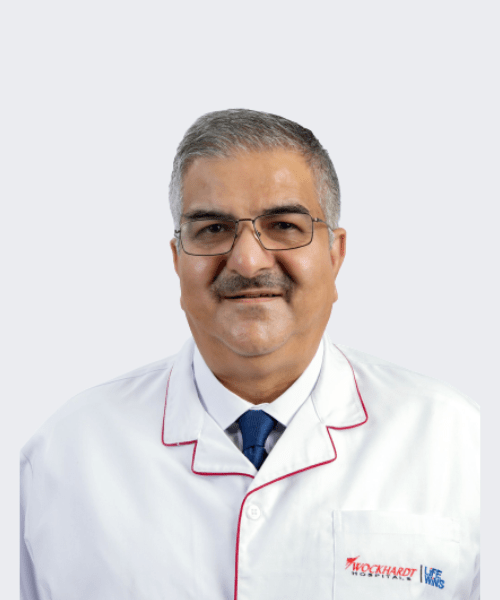Home » Speciality » Spine Care
Best Hospital for
Spine Surgery in India
spinal conditions, including spine surgery.

Why choose Wockhardt Hospitals
for Spine Surgery?
Wockhardt Hospitals are well known for extensive specialization in spine surgery. We have a team of dedicated and highly experienced spine surgeons, physiotherapists, neuro-physicians, and pain block experts to offer the most precise diagnosis and spine treatment. From counseling through diagnostic procedures and surgeries, our professionals will lead you through the process. Our world-class surgeons and doctors strive to give expert advice and only recommend surgery when needed. A technologically advanced physical therapy and rehabilitation department at Wockhardt Hospitals is a great complement making us the best hospital for spine surgery in India.
Renowned Spine Surgeons
at Wockhardt Hospitals
The following are the spine surgery at Wockhardt hospital :
- Mumbai Central
- Mira Road
- Nagpur
- Rajkot
What is Spine Surgery?
Back injuries have become a problem affecting most people around the world. To treat back problems, doctors recommend spinal surgeries consisting of performing surgery to correct any possible structural abnormalities in the back. It allows surgeons to compress, move, and fix vertebral structures and replace them if required. There are several types of spine surgery, such as :
- Discectomy
Discectomy includes removing the herniated section of the disc to access the inflamed nerve and reduce its discomfort.
- Laminectomy
To release pressure caused by stenosis, the bone that covers the vertebrae is removed and expanded.
- Fusion
Spinal fusion of the spine together. This can ease pain by stabilizing a fracture or getting rid of the pain that originates from the movement of the vertebrae, which can cause some vertebral discs to deteriorate or become injured.
- Disc Implant
A disc implant is an alternative to a fusion transplant, where a disc is implanted in the patient’s spine. However, it cannot be used by everyone.
When Do you Need
Spine Surgery?
Suppose you have back and spinal pain due to the compression of a nerve, or you are experiencing spinal deformity, spine tumor, trauma, spinal infections, and degenerative spine conditions such as stenosis and herniated discs. In that case, the doctors might recommend spine surgery.
You might need spine surgery when you are under constant excruciating, unrelenting, and resistant to all forms of non-surgical treatments. Also, if you have already been treated for scoliosis and are feeling the condition is worsening, and you are experiencing pain, weakness, numbness, and back stiffness – talk to your doctor; there might be a need for spine surgery. If you have a spinal injury, there is no other way to treat them but surgery.
Also, some spine problems can be treated at home without surgery – only the ones with minor issues. Physical therapy, home exercises, medication, and spinal injections are really helpful in curbing the condition. If all these options fail, then surgery becomes the only option.
Diagnostic Tests for
Spine Surgery
If you have a complaint of neck pain, shoulder pain, etc., the doctor might have to conduct a few lab tests to rule out the metabolic abnormalities before confirming the condition. The tests for spine surgery include the following :

- X-rays can reveal vertebral or spinal column problems, fractures, tumors, or degenerative changes in the spine.
- If any abnormalities are found in the X-rays, the doctors recommend doing a CT scan as it gives out a clear picture to identify the injury.
- MRI uses strong radio waves and magnetic fields to generate images from the computer.
Spine Surgery
Procedure to be Performed for Spine Surgery
Spine surgery includes traditional lumbar fusion, microdiscectomy, and laminectomy. All the procedures are discussed in brief below :
- Laminectomy is used to treat spinal stenosis or pressure on the nerve of the lower back. An incision on the back allows the surgeon to remove the bone spurs and thickened ligaments pressing on the lower back nerves.
- Microdiscectomy is usually done to treat nerve pain due to herniated disc impinging a nerve in the spine. During the surgery, the doctors make a small incision in the lower back and remove the herniated disc.
- Traditional lumbar fusion is a spine procedure that includes using bone from the patient's body to fuse one vertebra to another. The surgeons place surgical screws on the vertebrae to stabilize the movement and assist with fusion. This process is usually used to stabilize the spine, scoliosis, severe disc degeneration, and a combination of any of these conditions.
- Spine tumor removal is performed to completely or partially remove the problematic or potentially harmful tumor from the spine. This tumor can be malignant or benign and should only be removed by experienced and expert surgeons.
Some of the most common spine treatment surgeries are Lateral Lumbar Interbody, Percutaneous Implementation, and Minimally Invasive Transforaminal Lumbar Interbody Fusion.
What happens during a
Spine Treatment?
Doctors usually opt for two surgical methods. One is open surgery which involves a long and open surgical approach where the doctor examines and accesses the spine operational space. However, in minimally invasive surgeries, the surgeon makes a small incision to guide the instrument or microscopic camera, where the video is recorded live, and the surgeon operates using it. They use specialized tools to go through the incision. Some of the minimally invasive surgeries include –
- Surgical spine procedure using a tubular retractor
- Full endoscopic surgery is minimally invasive, and the surgeon makes an incision of 4 to 6 mm in the flank. Then, the doctor removes the affected discs under epidural analgesia or local anesthesia.
- Percutaneous endoscopic surgery is a minimally invasive surgery for decomposing the lumbar disc spaces.
- Thoracoscopic access surgery
Benefits of
Spine Surgery
At Wockhardt hospital, we prefer minimally invasive surgery for spine treatment, as it offers several benefits such as –
- Less Painful
Minimally invasive surgery includes small incisions and less damage, which means less pain. Also, a minimally invasive surgery reduces or eliminates the chance of trauma your body takes in after an extensive surgical spine operation.
- Faster Recovery
You undergo to get rid of the pain you have been experiencing for ages. Thus, a minimally invasive surgery requires less amount of recovery time than open surgery. A faster recovery means you can get back to your daily activities early.
- Fewer Complications
Every surgery comes with risks, which also include minimally invasive procedures. Some of the common complications are – reactions to anesthesia and infection at the operation site.
How to Recover Fast After
Spine Surgery?
After undergoing spine surgery, you must rest properly to ensure you heal quickly. Keep yourself hydrated as it helps the nutrients flow properly, assisting in joint and organ maintenance. Also, eating protein-rich and whole foods will help you heal efficiently. Foods such as beans, nuts, whole grains, seeds, fruits, veggies, chicken breast, and salmon are the best diet after surgery.
What are the differences between
Traditional and Minimally Invasive Spine Surgery?
| Traditional Spine Surgery | Minimally Invasive Spine Surgery |
|---|---|
| Involves larger incisions | Compared to traditional surgery, MIS requires much smaller incisions. |
| More tissue and muscle disruption | Minimises damage to surrounding tissues |
| Higher risk of complications | Reduces the risk of post-surgical complications |
| Longer hospital stays | Shorter recovery and hospital stays |
| Longer rehabilitation period | Quicker return to normal activities |
| Significant scarring | Minimal scarring and less visible scars |
FAQs on Spine Care
Q. What are the benefits of regular exercise in spine care routines?
Regular exercise in spine care regimens has various advantages, including better flexibility, strength, and posture, which can help relieve pain and minimise the chance of injury. Exercise also improves circulation, which assists in the transport of nutrients to spinal tissues, promoting overall spinal health and functionality.
Q. How does ageing affect spine care needs?
Degenerative changes in the spine, such as reduced disc hydration, loss of bone density, and spinal arthritis, are often brought on by aging. Spinal stenosis and osteoporosis are among the disorders that may arise from these alterations. Therefore, in order to control pain, preserve mobility, and avoid problems, ageing raises the need for spine care.
Q. How do I find the best spine hospital in India?
When selecting the best spine hospital in India, analyse factors such as hospital reputation, spine surgeon expertise, spine surgery success rates, accessible technology and facilities, patient feedback, and accreditation. Make an educated decision by conducting internet research, consulting with medical specialists, and seeking advice from reliable sources.
Q. What are the dos and don'ts of spine surgery?
| Dos | Don’ts |
|---|---|
| Wear braces for a few months to ensure stabilization. | Don’t lift, bend, or twist for a few months after the surgery. |
| Eat a healthy diet. | Don’t overdo the walking. |
| Do physical therapy as it helps with postoperative pain. | Don’t forget to follow the medications and other recommendations by the doctor. |
| Visit the doctor if you face any omplications after the surgery. | Don’t hide any pain or medical problems you face from your doctor. |
Q. How serious is spinal surgery?
Q. Is spine surgery affordable?
As the surgery involves advanced technologies, the cost of the surgery would ultimately go higher. Usually, spine surgery in India costs around 200,000 to 250,000 INR. However, the cost depends on the following factors
- Consultation fees
- Admission fees
- Age of the patient
- Implants used
Also, the price of spine surgery depends on the location of the hospital, as the cost varies depending on the geographical location
Q. Is there an age limit for a spine operation?
Q. How many hours does spine surgery take?
Q.What is the most common spine surgery?
There are four primary types of surgeries that account for around 90% of all spine surgeries:
- Discectomy
- Laminectomy/laminotomy
- Spinal decompression and fusion
- Anterior cervical discectomy and fusion
Q.What is the cost of spine surgery in India?
The cost of spine surgery in India varies depending on the procedure, hospital, and additional medical requirements, but it’s usually more affordable compared to many Western countries. On average, it ranges from 2 lakhs to 6 lakhs.
Q.What is the success rate of spine operation in India?
The success rate of spine operations in India is notably high, often exceeding global standards. With experienced surgeons, advanced technology, and comprehensive pre- and post-operative care, the success rate stands at around 80-90%, depending on the specific procedure and patient condition.





















